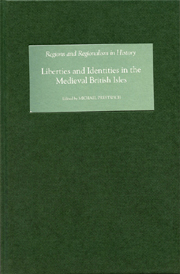Book contents
- Frontmatter
- Contents
- List of maps
- Abbreviations
- Introduction
- 1 States, liberties and communities in medieval Britain and Ireland (c.1100–1400)
- 2 Arbitration and Anglo-Scottish border law in the later middle ages
- 3 Peacekeepers and lawbreakers in medieval Northumberland, c.1200–c.1500
- 4 War, lordship, and community in the liberty of Norhamshire
- 5 The lordship of Richmond in the later middle ages
- 6 ‘Tam infra libertates quam extra’: Liberties and military recruitment
- 7 Neighbours from Hell? Living with Tynedale and Redesdale, 1489–1547
- 8 Striving for Marcher liberties: The Corbets of Caus in the thirteenth century
- 9 Franchises north of the border: Baronies and regalities in medieval Scotland
- 10 The liberties of Ireland in the reign of Edward I
- Index
9 - Franchises north of the border: Baronies and regalities in medieval Scotland
Published online by Cambridge University Press: 12 September 2012
- Frontmatter
- Contents
- List of maps
- Abbreviations
- Introduction
- 1 States, liberties and communities in medieval Britain and Ireland (c.1100–1400)
- 2 Arbitration and Anglo-Scottish border law in the later middle ages
- 3 Peacekeepers and lawbreakers in medieval Northumberland, c.1200–c.1500
- 4 War, lordship, and community in the liberty of Norhamshire
- 5 The lordship of Richmond in the later middle ages
- 6 ‘Tam infra libertates quam extra’: Liberties and military recruitment
- 7 Neighbours from Hell? Living with Tynedale and Redesdale, 1489–1547
- 8 Striving for Marcher liberties: The Corbets of Caus in the thirteenth century
- 9 Franchises north of the border: Baronies and regalities in medieval Scotland
- 10 The liberties of Ireland in the reign of Edward I
- Index
Summary
Scottish franchises – especially the late medieval regalities, equivalent to English palatinates – have not had a good press from past historians. The common attitude is neatly caught in two statements from the 1950s: William Croft Dickinson (author of what is still the main institutional study of the subject) declared in 1952 that in late medieval Scotland ‘franchisal privileges grew, flourished and were assumed unchecked’, while in 1958 Peter Mclntyre wrote (in the standard Introduction to Scottish Legal History) that the lords of regality ‘used the privileges they wrested from the weak kings of 14th century Scotland to establish an alternative system of government’. But that generation of historians developed their ideas within the crown-focused traditions of pre-1960s medieval English historiography, so it is hardly surprising that they had an anti-franchisal stance worthy (ironically in a Scottish context) of Edward I and his centralising lawyers.
However, at about the same time as Dickinson and Mclntyre were writing, J.R. Strayer (whose ideas started with France rather than England) was developing a very different line, presented in two seminal, though neglected, essays on feudalism. His basic argument was that the concept of feudalism should be understood ‘to mean a type of government which was conspicuous in Western Europe from about 900 to 1300 and which was marked by the division of political power among many lords and by the tendency to treat political power as a private possession’.
- Type
- Chapter
- Information
- Liberties and Identities in the Medieval British Isles , pp. 155 - 199Publisher: Boydell & BrewerPrint publication year: 2008



